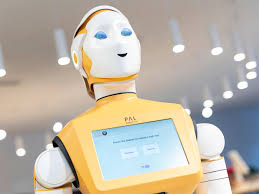Source: spectrum.ieee.org
THE INSTITUTE Scientists around the world are pushing hard to develop new technologies to support frontline workers during the COVID-19 pandemic. While much of this tech includes assistive tools to support frontline workers with their tasks, some researchers have their eye on ways to reduce the need for these employees to conduct high-risk tasks—by giving the jobs to robots.
One of those researchers is IEEE Member Francesco Ferro, CEO of PAL Robotics. He contacted The Institute to let us know about the company’s arsenal of customizable robots.
Based in Barcelona, the company’s base models are designed for a variety of tasks, including socializing with people and transporting items. PAL Robotics has been exploring ways to use its existing base models—or build upon them—to aid in the fight against the COVID-19 pandemic. The effort has involved a lot of collaboration and adaptation in a short amount of time.
“The idea is to move fast and save lives,” Ferro says. “That is the all-important part.”
One model that could prove useful during the pandemic is Artificial Robot Intelligence (ARI), a mobile and social robot that can interact with people and ask them questions. PAL Robotics was already collaborating with seven other organizations—including ERM Automatismes Industriels, Heriot-Watt University, and the University of Trento—as part of a project called SPRING, to modify ARI for complex dialogue and interactions with people.
But as the pandemic began, the project’s partners agreed to broaden the focus to make it applicable in the fight against the virus.
With the right software, he says, ARI will be able to ask COVID-19 patients questions related to their symptoms, reducing how often healthcare workers must come into close contact with patients. Additional modifications to ARI will allow it to establish connections with e-health platforms and process patients’ medical data, Ferro says. The social robot could also be fitted with a thermal infrared camera to measure a person’s temperature.
“The goal is for the robot to be able to participate in different user cases in a hospital environment, such as welcoming newcomers to the waiting room, helping with check-in forms, providing information about the consultation agenda, acting as a guide to appointments, and also offering entertainment,” Ferro says. ARI will be able to give patients a more personalized experience, in part thanks to the sociability of the robot and its features such as voice recognition, deep learning, and ability to read emotions.
“Another particular advantage of ARI is that the robot can be teleoperated to enable caregivers to see, interact, and support patients in real time without physical interaction, which is very important in this pandemic period,” Ferro says.
PAL Robotics is also exploring ways to modify its mobile robot model, TIAGo Base (TIAGo stands for take it and go), to help out during the pandemic, Ferro says. A variety of add-ons can be incorporated into this bot, such as storage compartments to transport food and medications within hospitals.
The company is also planning to incorporate a UV light to kill viruses and bacteria. This adapted model, dubbed TIAGo Disinfection, could be sent into empty hospital rooms to systemically zap surfaces with the UV light, killing any lingering germs. PAL Robotics is currently collaborating with a UV light manufacturer to create the new robotic appendage. Like ARI, TIAGo Disinfection could be equipped with an infrared camera to record patients’ temperatures.
The open-source framework, Robotics Operating System, is being used to program the robots. This allows the project’s collaborators and clients to easily incorporate their own software to customize the robot for different applications.
Ferro says the lockdown in Spain temporarily affected the manufacturing of the robots but the real bottleneck for getting ARI and the other bots on the front lines is certification from the EU Commission for their use in a healthcare setting, which is still pending.
“We have done safety assessments where we evaluate different hazardous situations—such as unexpected movement of the robot, electrical hazards related to charging, and mechanical hazards related to coupling with the robot joints—by indicating the probability of it happening and severity of the situation,” Ferro says.
As part of the next stage of the SPRING Project, ARI will undergo testing with human volunteers at some pilot tests sites, including the Broca Hospital in Paris.
“We are now trying to complete the pilot tests and are trying to develop solutions faster in an agile way in order to fulfill the real needs [brought on by the pandemic],” Ferro says. “We are pushing very hard for this.”


